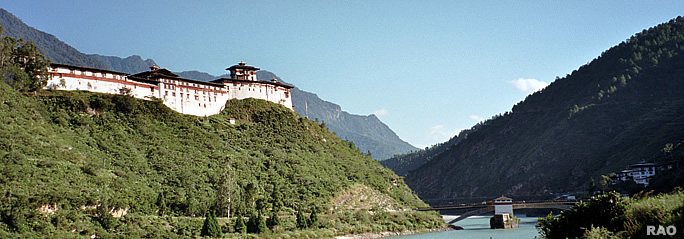 |
Bhutan Development |
|
 |
Bhutan Information |
|
|
 |
| United
Nations System in Bhutan |
| Briefing
Notes on Bhutan |
 |
 |
|
Construction
of hydropower projects accelerate growth
|
 |
 |
Bhutan's
GDP growth rose dramatically from 5.5% in 2006 to 17.6% in 2007. The spike
in growth reflected private investment in housing, public investment in
infrastructure and, most importantly, continued work on the Tala hydropower
project. |
 |
The
construction of such projects has governed the rhythm of economic activity
in Bhutan for several years, and will likely continue to determine it for
several more. Services maintained robust performance in 2007, driven chiefly
by the trade and financial sectors. |
 |
In
Bhutan the construction of two new hydropower projects will help to sustain
real GDP growth over the medium term. GDP is expected to grow at about
10% in 2008. |
 |
Inflation
rates remained high in most countries of South Asia as a result of pressures
from both the demand and supply sides. Higher prices of oil and other
commodities in international markets sustained inflationary pressures.
Food prices in general rose more rapidly, imposing extra burdens on low
and fixed income groups. Price changes in Bhutan largely follow those in
India, a country with which it has close trade and financial links. The
domestic currency is pegged to the Indian rupee. Inflation in Bhutan has
hovered around 5% in recent years. |
 |
Bhutan's
overall budget deficit, excluding income from grants, is quite large. If
grants are included it becomes more manageable. The budget deficit including
income from grants rose to 3.5% of GDP in 2007, from 0.8% in 2006. With
the Tala hydropower project coming on stream, a significant increase in
government revenue is expected to lower the deficit. |
 |
Bhutan's
trade balance improved in 2007, with large exports of electricity to India
and much of the Tala hydropower project coming on stream. The country's
current account balance turned to a surplus over the year, and is expected
to remain in surplus in the near future. |
 |
The
main challenge for countries in South Asia is to sustain their growth momentum
in the face of high oil prices. Very high oil prices will not only compromise
economic growth but add pressures on inflation, budget and balance of payments.
In such a situation, it is important that some measures are taken to hedge
the risk of high oil prices and more importantly to contain oil imports
through selective energy conservation measures. |
top
|
Addressing
the neglect of agriculture - two-pronged approach needed
|
 |
 |
The
rural poor account for around 70% of the poor in the Asia-Pacific region,
and agriculture is their main livelihood. Another worrisome trend is the
widening gap between the rich and the poor because the benefits of growth
are not shared equally by different sectors, regions or income groups.
Agriculture appears neglected, even though it still provides jobs for 60%
of the working population and generates about a quarter of the region's
GDP. Growth and productivity in agriculture are slowing, and the green
revolution has bypassed millions. In South Asia, growth in agriculture
output dropped from 3.6% in the 1980s to 3.0% in 2000-2003. |
 |
Agricultural
labour productivity has a significant impact on poverty reduction. ESCAP
estimates show that a 1% increase in agricultural productivity would lead
to a 0.37% drop in poverty in the Asia-Pacific region. Given the large
agriculture productivity gaps among countries in the region, the potential
gains appear substantial. Raising the region's average agricultural productivity
to that in Thailand can take 218 million people out of poverty, roughly
a third of total poor in the region. Large gains in poverty are also possible
through comprehensive liberalization of global agriculture trade, which
could lift a further 48 million people out of poverty in the region. |
 |
Therefore,
a policy priority should be to revitalize agriculture. This requires connecting
the poor to markets by improving rural infrastructure, improving availability
and management of water, improving agricultural technology, increasing
the capacity to adapt technologies, and speeding diversification and commercialization.
It also requires improving the distribution of land and the access to agricultural
credit and extension - and making macroeconomic policy friendlier to agriculture,
all enabling the poor to make a dent on poverty by themselves. |
 |
While
agriculture growth will help in reducing poverty particularly in rural
areas, yet some poor will shift from agriculture to industry and services,
which offer them a better chance of escaping poverty. Policies should
be put in place to make this transformation easy. Public policy could
thus adopt a two-pronged approach, taking both aspects into account; revitalizing
agriculture while facilitating the migration of excess labour from agriculture
to industry and services. Farmers can leave agriculture for non-farm activities
in rural areas or for work in urban areas. This requires creating
opportunities in the non-farm sector as well as urban planning. Both require
better opportunities for skills development and strategies for raising
overall economic growth. |
 |
 |
| Source:
The United Nations Economic and Social Commission for Asia and the Pacific
(ESCAP) 2008 |
top
| Information on Bhutan |
 |
| Links |
 |
 |
 |
External
links |
|



